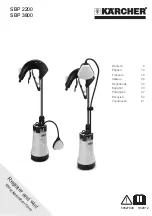
08 + ERLQ004~008
Daikin Altherma - Low Temperature Split
4P313774-1 – 2012.05
Installer reference guide
22
6 Preparation
Q
The indoor unit is designed for indoor installation only and for
ambient temperatures ranging 5~35°C in cooling mode and
5~30°C in heating mode.
6.2
Preparing refrigerant piping
6.2.1 Refrigerant piping insulation
Q
Use polyethylene foam as insulation material:
Q
with a heat transfer rate between 0.041 and 0.052 W/mK
(0.035 and 0.045 kcal/mh°C)
Q
with a heat resistance of at least 110°C
Q
Insulation thickness
6.2.2 Refrigerant piping requirements
Q
Use piping with annealed temper grade, in function of the pipe
diameter.
Q
The minimal pipe thickness should comply with applicable
legislation. The minimal pipe thickness for R410A piping must
be in accordance with the following table.
6.3
Preparing water piping
6.3.1 Water circuit requirements
Q
Use the indoor unit only in a closed water system.
Using the system in an open water system will lead to excessive
corrosion.
Q
The maximum water pressure is 4 bar.
Provide adequate safeguards in the water circuit to ensure that
the maximum pressure is NOT exceeded.
Q
All installed piping and piping accessories (valve,
connections,…) must withstand the following temperatures:
Q
Make all water piping connections in accordance with the
applicable legislation and the outlook diagram that is delivered
with the unit, respecting the water inlet and outlet.
Q
Do NOT use excessive force when connecting the piping.
Deformation of the piping can cause malfunctioning of the unit.
Q
Provide drain taps at all low points of the system in order to
allow complete drainage of the water circuit.
Q
Provide a proper drain for the pressure relief valve to avoid
water coming into contact with electrical parts.
Q
Provide air vents at all high points of the system, which must
also be easily accessible for servicing. An automatic air purge is
provided in the indoor unit. Check that the air purge is NOT
tightened too much, so that automatic release of air in the water
circuit is possible.
Q
Only use materials that are compatible with water used in the
system and with the materials used in the indoor unit.
Q
Check that all components in the field piping can withstand the
water pressure and water temperature.
Q
When using non-brass metallic piping, insulate the brass and
non-brass properly so that they do NOT make contact with each
other. This to prevent galvanic corrosion.
Q
Never use Zn-coated parts in the water circuit. Because the
unit's internal water circuit uses copper piping, excessive
corrosion may occur.
Q
Only use appropriate tooling to handle brass, which is a soft
material. If NOT, pipes will get damaged.
Q
Select the water piping diameter in relation to the required water
flow and the available external static pressure of the pump. See
"15 Technical data" on page 72 for the external static pressure
curves of the indoor unit.
Pipe outer diameter
(Ø
p
)
Insulation inner
diameter (Ø
i
)
Insulation
thickness (t)
6.4 mm (1/4")
8~10 mm
10 mm
15.9 mm (5/8")
16~20 mm
13 mm
Pipe for…
Outer diameter
(Ø)
Pipe thickness
(t)
Liquid
6.4 mm (1/4")
≥
0.8 mm
Gas
15.9 mm (5/8")
≥
1.0 mm
INFORMATION
The following illustration is an example and may NOT
match your system layout.
Ø
i
Ø
i
t
Ø
p
Ø
p
t
Ø
a
Outdoor unit
b
Indoor unit
c
Heat exchanger
d
Backup heater
e
Pump
f
Shut-off valve
g
Motorised 3-way valve (supplied with the domestic hot
water tank)
h
Motorised 2-way valve (field supply)
i
Collector
j
Domestic hot water tank
k
Heat exchanger coil
l
Booster heater
FCU1...3
Fan coil unit (optional)
FHL1...3
Floor heating loop
T
Room thermostat (optional)
65°C
65°C
M
M
T
FCU2
FCU3
FHL1
FHL2
FHL3
a
b c
d
e
f
g
f
h
i
i
i
i
j
k
l
















































